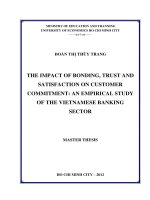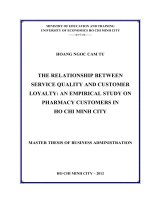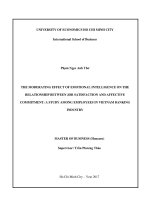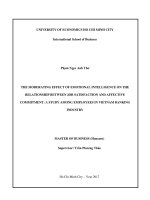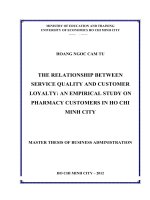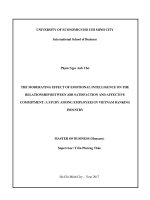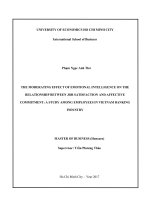Relationship between communication astisfaction and affective commitment - an empirical study in the Vietnamese banks
Bạn đang xem bản rút gọn của tài liệu. Xem và tải ngay bản đầy đủ của tài liệu tại đây (944.51 KB, 74 trang )
UNIVERSITY OF ECONOMICS HO CHI MINH CITY
International School of Business
HOANG THI KIM KHANH
RELATIONSHIP BETWEEN
COMMUNICATION SATISFACTION AND
AFFECTIVE COMMITMENT
- AN EMPIRICAL STUDY
IN THE VIETNAMESE BANKS
MASTER THESIS OF BUSINESS ADMINISTRATION
SUPERVISOR: DR. NGUYEN THI NGUYET QUE
HO CHI MINH CITY – 01/2014
UNIVERSITY OF ECONOMICS HO CHI MINH CITY
International School of Business
HOANG THI KIM KHANH
RELATIONSHIP BETWEEN
COMMUNICATION SATISFACTION AND
AFFECTIVE COMMITMENT
- AN EMPIRICAL STUDY
IN THE VIETNAMESE BANKS
ID: 22110029
MASTER THESIS OF BUSINESS ADMINISTRATION
SUPERVISOR: DR. NGUYEN THI NGUYET QUE
HO CHI MINH CITY – 01/2014
Running head: Relationship between communication satisfaction and affective commitment – an empirical study in the
Vietnamese banks
Relationship between communication satisfaction and affective commitment – an empirical
study in the Vietnamese banks
Hoang Thi Kim Khanh
19th January, 2014
ISB Research Committee
i
Relationship between communication satisfaction and affective commitment – an empirical study in the Vietnamese banks
ACKNOWLEDGEMENTS
I would like to thank my supervisor Dr Nguyen Thi Nguyet Que for the guidance,
patience and support during my thesis’s writing period.
I am also grateful to all ISB members who helped me with necessary materials and
paper submission.
I would like to appreciate all my friends and responders for their contribution to my
survey.
Especially, I would like to give my special thanks to my family who always
encourage me throughout my life.
Hoang Thi Kim Khanh
Ho Chi Minh city, 20th December, 2013
ii
Relationship between communication satisfaction and affective commitment – an empirical study in the Vietnamese banks
ABSTRACT
The main purpose of this study is figure out the relationship between communication
satisfaction’s factors (personal feedback, communication climate, horizontal communication,
supervisory communication) with affective commitment in Vietnamese banking industry.
These factors are tested in previous studied in the world, and the previous result indicated that
all of them have a positive impact to commitment. After conducting a research, collecting and
analysing 225 employees in many banks in Ho Chi Minh City, the result indicated that first,
the horizontal communication was divided into new components, horizontal formal
communication and horizontal informal communication. Second, only communication
climate, supervisory communication and horizontal formal communication affects to
affective commitment. Third, communication climate is a strongest factor contributes to
employee affective commitment. Personal feedback and horizontal informal communication
do not have influences on affective commitment in Vietnam banking industry.
Although having a few limitations, but this study highlights the importance of
communication satisfaction in workplace. It is necessary for banking managers to develop
good relationships with their employees to improve employee affective commitment. The
conclusion of this study discusses the practical implications for managers and the
recommendation for future research.
iii
Relationship between communication satisfaction and affective commitment – an empirical study in the Vietnamese banks
TABLE OF CONTENT
ACKNOWLEDGEMENTS .............................................................................................ii
ABSTRACT ......................................................................................................................iii
LIST OF TABLES ..........................................................................................................vii
LIST OF FIGURES .......................................................................................................viii
CHAPTER 1: INTRODUCTION ....................................................................................1
1.1 BACKGROUND ..........................................................................................................1
1.2 RESEARCH OBJECTIVES AND QUESTIONS ........................................................3
1.3 SIGNIFICANT OF THE STUDY ................................................................................3
1.4 RESEARCH SCOPE AND METHODOLOGY ..........................................................4
1.5 THESIS STRUCTURE .................................................................................................4
CHAPTER 2: LITERATURE REVIEW AND HYPOTHESIS ...................................6
2.1 COMMUNICATION SATISFACTION ......................................................................6
2.1.1 Definition of communication ...........................................................................6
2.1.2 Definition of communication satisfaction ........................................................6
2.1.3 Dimensions of communication satisfaction ......................................................7
2.2 ORGANIZATIONAL COMMITMENT AND AFFECTIVE COMMITMENT .........8
2.2.1 Definition of organizational commitment .........................................................8
2.2.2 Dimensions of organizational commitment.......................................................9
2.2.3 Affective commitment .....................................................................................10
2.3 COMMUNICATION SATISFACTION AND ORGANIZATIONAL COMMITMENT
...........................................................................................................................................11
2.4 PROPOSED MODEL AND HYPOTHESIS .............................................................12
2.4.1 Personal feedback and affective commitment .................................................13
2.4.2 Communication climate and affective commitment........................................14
iv
Relationship between communication satisfaction and affective commitment – an empirical study in the Vietnamese banks
2.4.3 Horizontal communication and affective commitment ...................................14
2.4.4 Supervisory communication and affective commitment .................................15
2.5 RESEARCH MODEL AND HYPOTHESIS .............................................................15
2.6 CONCLUSION ...........................................................................................................16
CHAPTER 3: METHODOLOGY .................................................................................17
3.1 RESEARCH DESIGN PROCESS..............................................................................17
3.2 QUESTIONNAIRE DEVELOPMENT .....................................................................18
3.2.1 Measurement scale .........................................................................................18
3.2.2 Questionnaire design ......................................................................................22
3.3 PILOT STUDY ..........................................................................................................22
3.3.1 Purpose of pilot study .....................................................................................22
3.3.2 Method of pilot study .....................................................................................22
3.3.3 Result of pilot study ........................................................................................23
3.4 MAIN SURVERY .....................................................................................................23
3.4.1 Sampling method ............................................................................................23
3.4.2 Sample size .....................................................................................................24
3.4.3 Questionnaire administration ..........................................................................24
3.5 DATA ANALYSIS TECHNIQUE ............................................................................24
3.5.1 Cronbach’s alpha ............................................................................................25
3.5.2 Exploratory factor analysis (EFA) ..................................................................25
3.5.3 Multiple regression analysis ...........................................................................26
3.6 CONCLUSION ............................................................................................................26
CHAPTER 4: DATA ANALYSIS AND RESULTS ....................................................28
4.1 DESCRIPTIVE ANALYSIS ......................................................................................28
4.2 MEASUREMENT ASSESSMENT.............................................................................29
v
Relationship between communication satisfaction and affective commitment – an empirical study in the Vietnamese banks
4.2.1 Cronbach’s Alpha ............................................................................................29
4.2.2 Exploratory factor analysis ............................................................................32
4.3 MULTIPLE REGRESSION ANALYSIS ...................................................................37
4.3.1 Assumption testing ..........................................................................................37
4.3.2 Result of regression analysis ...........................................................................38
4.4 CONCLUSION ............................................................................................................40
CHAPTER 5: DISCUSSION AND CONCLUSION ....................................................42
5.1 DISCUSSION OF FINDINGS ....................................................................................42
5.2 CONCLUSION ............................................................................................................43
5.3 PRACTICAL IMPLICATIONS ..................................................................................44
5.4 LIMITATIONS OF THE STUDY...............................................................................46
5.5 RECOMMENDATIONS FOR FUTURE RESEARCH..............................................46
REFERENCES ................................................................................................................48
APPENDIX A ..................................................................................................................53
APPENDIX B ..................................................................................................................55
APPENDIX C ..................................................................................................................57
APPENDIX D ..................................................................................................................58
APPENDIX E ..................................................................................................................60
APPENDIX F ...................................................................................................................64
vi
Relationship between communication satisfaction and affective commitment – an empirical study in the Vietnamese banks
LIST OF TABLES
Table 01: Scale of personal feedback ...............................................................................19
Table 02: Scale of communication climate ......................................................................19
Table 03: Scale of horizontal communication ..................................................................20
Table 04: Scale of supervisory communication ................................................................20
Table 05: Scale of affective commitment .........................................................................21
Table 06: Cronbach’s Alpha Reliability Coefficient ........................................................25
Table 4.1 Sample Description ............................................................................................28
Table 07: Reliability analysis ...........................................................................................30
Table 08: Summary of Cronbach’s Alpha ........................................................................32
Table 09: KMO and Barrtlett’s Test .................................................................................33
Table 10: Total Variance Explained in EFA process .......................................................34
Table 11: Factors loading ................................................................................................35
Table 12: Model Summary ...............................................................................................38
Table 13: ANOVA ............................................................................................................38
Table 14: Correlations .......................................................................................................60
Table 15: Model Statistics .................................................................................................61
Table 16: Coefficients .......................................................................................................39
Table 17: Result of testing hypothesis ..............................................................................40
vii
Relationship between communication satisfaction and affective commitment – an empirical study in the Vietnamese banks
LIST OF FIGURES
Figure 01: A conceptual model ........................................................................................16
Figure 02: Research design process .................................................................................17
Figure 03: A new conceptual model .................................................................................37
Figure 04: Overall regression plot ....................................................................................62
Figure 05: Histogram of Affective Commitment .............................................................62
Figure 06: Normal P-P Plot of Affective Commitment ....................................................63
viii
Relationship between communication satisfaction and affective commitment – an empirical study in the Vietnamese banks
CHAPTER 1: INTRODUCTION
The first chapter presents the research background, research questions, research
objectives, value of the research and thesis structure.
1.1
Background
The key factor for any achievement of one organization is not only the huge capital
but also the power of human. In the analysis of Mathieu and Zajac (1990) states that
organizational commitment is an antecedent of job performance, intention to leave, lateness
and turnover ; moreover, according to Cooper-Hakim and Viswesvaran (2005) organizational
commitment is negatively related to turnover; according to Memari, Mahdieh & Marnani,
(2013), organizational commitment is positively related to job performance. Therefore,
employee’s organizational commitment plays an important role to prevent the potential risk
of human resource management.
Communication is very important to all of organizations in the world. Effective
communication is key point for organizational success. All of the activities in one
organization involve with the communication. Most of the managers focus to do business and
only a few of them take care of how to communicate effectively to create a smooth working
condition. A well-informed person have better attitude than a less-informed person. Many
kinds of verbal and nonverbal communication help in moulding employee’s attitudes. Hence,
employee satisfaction with communication at work is very important to all organization.
Previous studies implicate that communication satisfaction is positively related to
organizational commitment (Putti et al, 1990; Varona, 1996, Carrie`re & Bourque, 2009).
Therefore, there exists a correlation between communication satisfaction and organizational
commitment. Besides, according to Downs and Hazen (1977), communication satisfaction
has eight dimensions. Based on the result of previous studies (Putti et al, 1990; Down, 1991;
Potvin, 1991; Varona, 1996, only four factors (personal feedback, horizontal communication,
1
Relationship between communication satisfaction and affective commitment – an empirical study in the Vietnamese banks
supervisory communication, and communication climate) have strong relationship with
organizational commitment.
Banking industry is one of the most important industries in Vietnam and banking
business is very challenging. However, according to “Cafebiz electronic magazine” in current
situation of banking industry, the employee’s salary and benefit are cut off. Moreover,
according to Ánh Hồng & Hải Đăng (2013) on the “tuoi tre online news”, the banks also
displace employee, give the employee the huge credit target, find out the small mistake of
employees to make a reason for laying off the employees. All of these activities put a
pressure to the staffs who are working at the banks. The manager spend a lot of time to
implement the communication techniques; besides, in the current situation, the huge credit
target affects to managers and supervisors; therefore, the pressure from the credit target make
supervisor’s communication not good enough when facing with the staffs. Problem in
supervisory communication happens. Besides, the way one bank displaces and lays off the
employees creates the high competition between the staffs, that lead to the healthy
competetion or unhealthy competetion between employees. Therefore the problem of
horizontal communication happens. Moreover, the banks focus to the small mistake of
employees for finding out the reason to lay off them, that make the personal feedback not
objective and accuracy; therefore, the problem of communication on personal feedback
happens. The pressure from those activies above lead to a unhealthy and pressuring
communication climate. People working in the pressure environment with the unhealthy
atmosphere at workplace. As the result, the problem of communication climate happens.
As mentioned above, previous researches figure out that communication satisfaction
positively impacts to organizational commitment. Hence, there is an issue that in Vietnamese
banking industry whether communication satisfaction affects to organizational commitment
or not, whether four factors (personal feedback, horizontal communication, supervisory
2
Relationship between communication satisfaction and affective commitment – an empirical study in the Vietnamese banks
communication, and communication climate) affects to organizational commitment or not.
Lack of communication satisfaction among banks in Vietnam may contribute to a low
organizational commitment. Therefore, this paper will figure out the relationship between
four communication satisfaction’s factors to organizational commitment in the Vietnamese
banks.
1.2
Research objectives and questions
The consequences of ineffective communication in an organization may lead to a lack
of employee commitment. In contrast, the effective communication may be considered a
reason to stay with the organization. In research of Carrie`re & Bourque (2009) and study of
Meyer and Allen (1990) mentions that only affective commitment is the most important
factors reflect organizational commitment strongly. Therefore, the purpose of this study is
exploring the impacts of four dimensions of communication satisfaction (personal feedback,
horizontal communication, supervisory communication, and communication climate) to one
important type of organizational commitment – affective commitment.
This research questions are
1) What are the impacts of personal feedback, horizontal communication,
supervisory communication, and communication climate to affective
commitment?
2) How do they influence to the affective commitment?
1.3
Significant of the study
The research provides results of empirical research in employees’ attitudes towards
particular communication satisfaction and organizational commitment. The relationship
between some dimensions of communication satisfaction and affective commitment is
explored too.
3
Relationship between communication satisfaction and affective commitment – an empirical study in the Vietnamese banks
This study’s exploration is new theoretical topic in Vietnam. The theoretical value is
providing the theoretical knowledge about the role of communication satisfaction in a
relationship with organizational commitment in Vietnamese context.
Regard to the managerial implications, this finding will help managers of the banks in
Vietnam understand obviously about the components of communication satisfaction affect to
their employees’ affective commitment, whereby they can improve their human resource
management to increase the employees’ commitment. The practical value of this paper is that
the data analysis of this research may let the manager know how much the employees take
care of communication at workplace. At the point of view of employee, the employer may
have the strategies to avoid the potential risk related to communication satisfaction
1.4
Research scope and methodology
This research just focuses on employees who work at least one year in their current
bank. Besides, they do not work in a managerial position. The area of this study is only in Ho
Chi Minh City, and Long An province.
The methodologies of this research are quantitative method and qualitative method.
The pilot study of qualitative method is used to check the meaning and to edit the Vietnamese
word of the measurement scale in order to make a lager survey in Vietnamese context. The
quantitative method conducts the main survey and collect data to test the hypotheses by using
the questionnaire.
1.5
Thesis structure
This thesis is organized as follows:
Chapter 1 presents the research background, research problems, research questions, research
objectives, and thesis structure.
Chapter 2 introduces research model and its hypotheses as well as its literature review
Chapter 3 illustrates the methodology conducted in this paper
4
Relationship between communication satisfaction and affective commitment – an empirical study in the Vietnamese banks
Chapter 4 presents research results is based on data collected
Chapter 5 summarizes the research results, provide the findings and recommendations.
5
Relationship between communication satisfaction and affective commitment – an empirical study in the Vietnamese banks
CHAPTER 2: LITERATURE REVIEW AND HYPOTHESIS
In this chapter, literatures reviews communication satisfaction and its dimensions.
Besides, this chapter also reviews the organizational commitment and affective commitment.
Finally, after reviewing the relationship between communication satisfaction and
organizational commitment, the new developing model and hypothesis will be shown.
2.1
Communication satisfaction
2.1.1
Definition of communication
According to Dwyer (2005), he says, “communication is necessary for passing
information between people working in the same company and between company and other
organization. Communication includes written, oral and nonverbal. Communication is used
by management to direct and motivate employees and to evaluate their performance. The
purpose of organization is to control, motivate and balance needs and goals” (p.219)
2.1.2
Definition of communication satisfaction
Redding (1972) mentions that communication satisfaction is related to some
components such as changing in organization, understanding job requirements, accessing to
important information, accessibility of superiors, and explanation of policies.
Thayer (1968) defines communication satisfaction as “the personal satisfaction
inherent in successfully communicating to someone or in successfully being communicated
with” (p. 144). According to Hecht (1978), communication satisfaction means a
communication event fulfil positive expectations. Crino and White (1981) define the
communication satisfaction as “the satisfaction with various aspects of communication in an
organization” (p. 832)
Besides, Kandlousi et al. (2010) defines communication satisfaction as the level of
satisfaction an employee has between the overall communication flow and relationship
variables within their organization
6
Relationship between communication satisfaction and affective commitment – an empirical study in the Vietnamese banks
Although there are many definitions about communication satisfaction, but all of them
just tell about the satisfaction with different parts of communication at workplace.
2.1.3
Dimensions of communication satisfaction
For measuring employees' communication satisfaction, Downs and Hazen (1977)
develops the Communication Satisfaction Questionnaire (CSQ). This theory is confirmed in
many studies in the world such as study of Clampitt & Girard, 1987; Verona, 1996; Carrie`re
& Bourque, 2009. Bakanauskiene et al (2010) reviewed the relationship between
communication satisfaction and job satisfaction in Lithuania’s university by using theory of
Downs and Hazen (1977). Besides, Gray and Laidlaw (2002) also state that CSQ is the most
comprehensive instrument in reviewing the multidimensional concept communication
satisfaction. CSQ have eight dimensions as follow:
Communication Climate is one of the most important dimensions. When discussing
about communication satisfaction, people first think of communication climate. It estimates
whether or not the organization's communication stimulates or motivates to meet
organizational goals and whether or not it encourages employee to identify with the
organization. It also measures whether or not employee’s attitudes towards communication is
healthy in the organization.
Supervisory communication includes the upward and downward communication
with supervisors. It measures the level to which a superior is open to ideas, the level to which
the superior listens and pays attention, and the level to which is related to solving problems.
Organizational Integration concerns about the information employees receive about
their job such as policies, payment and benefits. Besides, it also includes information about
what is happening in organization, departmental plans and some personnel news.
7
Relationship between communication satisfaction and affective commitment – an empirical study in the Vietnamese banks
Media Quality is related to communication with several channels (e.g., publications,
memos, and meetings). On the other hand, it also measures the helpfulness, clarity of
information sources and the quantity of information.
Horizontal communication also calls co-worker communication. It deals with the
amount of activity of information networks and the accuracy of the information.
Organizational Perspective is related to some information that given out concerning
the corporation and its goals and performance. It has some items that are related to changing
in organization, information about the organization's financial standing, and policies and
goals of the organization
Personal Feedback is concerned with the way that employees are judged and the way
that their performance is appraised. It also measures about the individuals think that their
efforts are recognized.
Relationship with Subordinates only focuses to ask people who work in supervisory
or managerial position. It measures upward and downward communication with subordinates.
Workers in managerial positions respond to some items that include subordinate
responsiveness to downward communication and capability to send good information upward.
2.2
Organizational commitment and affective commitment
2.2.1
Definition of organizational commitment
There are so many definitions about organizational commitment. Mowday et al. (1982,
p.27) mentions about three components of organizational commitment as “a strong belief in
and acceptance of the organization’s goals, a willingness to exert considerable effort on
behalf of the organization, and a definite desire to maintain organizational membership”.
Besides, Mowday et al. (1982) mentions about organizational commitment related to attitude
and behaviours. Mowday et al. (1982) states as follows
8
Relationship between communication satisfaction and affective commitment – an empirical study in the Vietnamese banks
“Attitudinal commitment focuses on the process by which people come to think about
their relationship with the organization. In many ways, it can be thought of as a mind set
in which individuals consider the extent to which their own values and goals are
congruent with those of organization. Behavioral commitment, on the other hand, relates
to the process by which individuals become locked into a certain organization and how
they deal with this problem.” (p. 26)
Bateman and Strasser (1984) defines organizational commitment as “multidimensional in
nature, involving an employee’s loyalty to the organization, willingness to exert effort on
behalf of the organization, degree of goal and value congruency with the organization, and
desire to maintain membership” (p.95).
2.2.2
Dimensions of organizational commitment
Meyer and Allen (1984) describe organizational commitment as two dimensions;
affective commitment, and continuance commitment. Meyer and Allen (1990) adds one more
dimension of organizational commitment, a third dimension is normative commitment.
Affective commitment is defined as “the attachment of an individual’s fund of
affectivity and emotion to the group”, says Kanter (1968, p. 507) or “the relatives strength of
an individual’s identification with and involvement in a particular organization”, says
Mowday et al (1979, p. 226). Moreover, Meyer and Allen (1997, p. 11) also defines affective
commitment as “the employees’ emotional attachment to, identification with, and
involvement in the organization”. According to Meyer and Allen (1997), affective
commitment is related to some factors such as feedback, goal clarity, peer cohesion, etc.
Kanter (1968, p.504) defines continuance commitment as “profit associated with
continued and a “cost” associated with leaving” or “awareness of the costs associated with
leaving the organization”, stated by Meyer and Allen (1997, p.11).
9
Relationship between communication satisfaction and affective commitment – an empirical study in the Vietnamese banks
According to Meyer and Allen (1990), normative commitment is less common but
still also a component of one’s responsibility to the organization. Meyer and Allen (1991,
p.67) states that normative commitment is “ought to remain with the organization” or Meyer
and Allen (1997, p.11) defines normative commitment as “a feeling of obligation to continue
employment”. Robbins (2001) believes that organizational commitment is a kind of work
attitudes. Employee identifies organizational goals and desires to maintain employees’ status
as one organizational member.
In conclusion, affective commitment means employees want to remain their
commitment with the organization emotionally. Continuance commitment means that
employees need to remain the commitment and normative commitment is what employees
feel they ought to do (Meyer and Allen, 1990).
2.2.3
Affective commitment
In three types of commitment (emotional attachment, cost-based and obligation of
commitment), Meyer and Allen (1990) considers that affective commitment is best
represented of organizational commitment. In the study of Mowday et al (1982), they support
that affective commitment is the most theme of organizational commitment. Moreover,
Carrie`re & Bourque (2009) believe that “affective commitment is more likely reflect primary
feelings and attitudes toward the job and its components, it dominates the organizational
commitment literature” (p. 34). All three forms of commitment, affective commitment is
strongly related to withdrawal cognitions and employee turnover, “especially had the
strongest and most favorable correlations with organization-relevant” (Meyer et al., 2002, p.
21). Therefore, affective commitment is the most important component of organizational
commitment.
10
Relationship between communication satisfaction and affective commitment – an empirical study in the Vietnamese banks
2.3
Communication satisfaction and organizational commitment
There are a few researches about the relationship between communication satisfaction
and organizational commitment.
In the review of Verona (1996), he mentions that Putti, Aryee, and Phua (1990)
explore the positive relationship between communication satisfaction and organizational
commitment in engineering company in Singapore. Putti, Aryee and Phua (1990) also
conclude that horizontal communication is the frequent factor affect to organizational
commitment; moreover, top management, and relationship to supervisor have strong
correlation with organizational commitment. Moreover, three authors figured out the
strongest factors affected to organizational commitment is satisfaction with top management
communication.
On the other hand, Verona (1996) also mentions about Potvin’s research in 1991.
According to Potvin (1991), communication satisfaction is positively related to
organizational commitment, the context in his research is three US organizations: a retail
company, a large hospital, and a multi- national high technology company in Texas. In his
research, horizontal communication also is a frequent predictor of organizational
commitment and two factors that have the strong relationship to organizational commitment
are communication climate and supervisory communication. The strongest factor is also
satisfaction with supervisory communication.
With the deep knowledge in this topic, Verona (1996) also reviews a research of
Downs (1991). In study of Downs (1991), there is a positive relationship between
communication satisfaction and organizational commitment in two Australian organizations.
Moreover, horizontal communication is also a predictor of organizational commitment.
Author concludes that three factors have the strong correlation with organizational
commitment are supervisory communication, personal feedback, and communication climate.
11
Relationship between communication satisfaction and affective commitment – an empirical study in the Vietnamese banks
In the study of Verona (1996), the positive relationship between communication
satisfaction and organizational commitment were also discovered. All of the communication
satisfaction’s dimensions appear as predictors of organizational commitment. However, in
context of three Guatemalan organizations, organizational integration and horizontal
communication are the most frequent predictors of organizational commitment.
The newest study about this topic is the study of Carrie`re & Bourque (2009). Two
authors study a positive relationship between communication satisfaction and affective
commitment in land ambulance service in Canada. Although Carrie`re & Bourque (2009) do
not mention about which communication satisfaction’s dimension has a strong relationship
with affective commitment, but two authors focuses to positive relationship between
communication satisfaction and affective commitment.
After discussing those studies above, in eight dimensions of Downs and Hazen (1977),
only five dimensions have a strong relationship with organizational commitment, these are:
supervisory communication, personal feedback, communication climate, horizontal
communication, organizational integration.
2.4
Proposed research model and hypothesis
After discussion in previous sections, affective commitment is the most important
component of organizational commitment. Moreover, affective commitment is also the most
important component that appropriates with the Vietnamese banking industry as discussed on
research objectives of chapter 1. Two components continuance commitment and normative
commitment will not be mentioned in this study.
The aim of this study is only focusing on communication satisfaction’s dimensions
that firstly have strong relationship with commitment; secondly, frequently affect to
commitment. In term of communication satisfaction, eight dimensions of Downs and Hazen
(1977) are confirmed by many previous researches. However, this study will not discuss
12
Relationship between communication satisfaction and affective commitment – an empirical study in the Vietnamese banks
about subordinate communication, because, the main responders in this study are employees
who do not work in a managerial or supervisory position in a bank. Besides, Verona (1996)
mentions that two factors media quality and organizational perspective are not significant
predictors of commitment in research of Putti et al (1990); Potvin (1991) and Downs (1991);
hence, media quality and organizational perspective will not be discussed in this study.
Although Verona (1996) stated that organizational integration has a strong relationship with
commitment, but this factor are not a significant factor in research of Putti et al (1990);
Potvin (1991) and Downs (1991); moreover the direct relationship between organizational
integration and commitment have not been studied in many researches before; hence,
organizational integration will not be discussed too.
As discussed above, supervisory communication, communication climate, and
horizontal communication positively, frequently affect to organizational commitment in
many previous studies. Therefore, three factors will be discussed in this research. In the study
of Downs (1991), personal feedback significantly affects to commitment in term of
communication satisfaction. Moreover, previous studies also figures out the direct
relationship between personal feedback and commitment. Hence, personal feedback will be
discussed too.
In conclusion, four factors of communication satisfaction supervisory communication,
communication climate, and horizontal communication, and personal feedback will be chosen
to discuss in this study. The next part will discuss about the direct relations hip between them.
2.4.1
Personal feedback and affective commitment
Ramaprasad (1983, p. 4) defines “feedback is information about the gap between the
actual level of performance and the reference or standard level which is subsequently used to
alter the gap in some way”. In Peters and Waterman (1982)’s view, a good way for
supervisors to give effective feedback for a job is giving formal and informal recognition.
13
Relationship between communication satisfaction and affective commitment – an empirical study in the Vietnamese banks
According to Larson (1989), positive feedback is shown to support commitment among
employees. Personal feedback needs an effective communication between the employees and
their managers to match the employee’s goals with organization’s goal (Sias, 2005).
Affective commitment is one important factor of organizational commitment; hence:
H1: Employee satisfaction with personal feedback positively influences to affective
commitment.
2.4.2
Communication climate and affective commitment
Keyton (2005) defines communication climate as “the atmosphere that results from
group members' use of verbal and nonverbal communication and listening skills; can be
defensive or supportive”. The study of Guzley (1992) suggests that employees' perceptions of
communication climate are correlated positively with the level of employees' organizational
commitment. Thus, employees satisfaction with the communication climate of the
organization has an emotionally attach to organization. Affective commitment is one
important factor of organizational commitment; hence:
H2: Employee satisfaction with communication climate positively influence to
affective commitment.
2.4.3
Horizontal communication and affective commitment
According to Bartels et al (2010), horizontal communication includes task-related and
informal contact; it occurs between employees in the hierarchy. Task-related communication
is related to task information. Informal contact contains conversations between employees
about personal matters not related to task performance.
Co-workers communicate horizontally to each other at workplace. Informal
communication is made when colleagues communicate socially during their work.
Employees build a relationship between employees at workplace. This relationship affect to
employees’ identification with the organization. According to Sias (2005), there is a positive
14
Relationship between communication satisfaction and affective commitment – an empirical study in the Vietnamese banks
relationship between high quality co-worker relations and organizational commitment. Meyer
& Allen (1997) found that employees that have a good relationship with their immediate
work group have higher levels of commitment. Affective commitment is one important factor
of organizational commitment; hence:
H3: Employee satisfaction with horizontal communication positively influences to
affective commitment.
2.4.4
Supervisory communication and affective commitment
Bakar & Mohamad (2004) defines “supervisory communication refers to process and
interactions that have been practiced by superiors towards subordinates with the purpose of
achieving task objectives and maintaining their relationships” (p.4). Jablin (1979) states that
employees who satisfied with supervisory communication are less likely to leave the
organization. There are a lot of study mentioned about the positive relationship between
supervisory communication and organizational commitment. In the study of Bakar &
Mohamad (2004), authors confirm that subordinates who get the high quality of supervisory
communication have higher organizational commitment. Hence, based on the study of Bakar,
Mustaffa & Mohamad (2009) and Bakar & Mohamad (2004), supervisory communication
has a positive impact on organizational commitment. Affective commitme nt is one important
factor of organizational commitment; hence:
H4: Employee satisfaction with supervisory communication positively influences to
affective commitment.
2.5
Research model and hypothesis
H1: Employee satisfaction with personal feedback positively influences to affective
commitment.
H2: Employee satisfaction with communication climate positively influences to
affective commitment.
15

